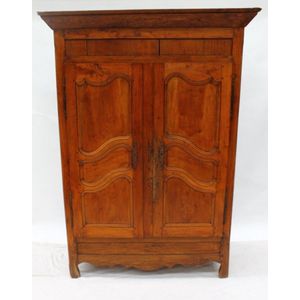18th Century French Walnut Buffet with Ironwork Escutcheons
You must be a subscriber, and be logged in to view price and dealer details.
Subscribe Now to view actual auction price for this item
When you subscribe, you have the option of setting the currency in which to display prices to $Au, $US, $NZ or Stg.
- Apron - A decorative wooden panel that sits underneath the top surface of a table or chair, and unites the top of the piece with the legs, running at right angles to the underside. On carcase furniture such as a chest or wardrobe, the apron sits below the drawers or doors and attaches to the legs.
On carcase furniture without legs the panel under the drawers or doors sits on the floor and is termed a plinth.
An apron can provide a decorative touch to an otherwise unadorned piece of furniture and at the same time provide structural support and strength. They can be carved or pierced and quite elaborate. - Escutcheons - An escutcheon is a plate, made of brass, wood, ivory or ebony, which fits into or over the h keyhole, to protect the edge of the timber keyhole from damage by continual insertions of the key. As a general rule you would expect these escutcheons to be sympathetic in design to the handles of the piece. From the early 19th century escutcheons were sometimes made from ivory, ebony, bone or contrasting wood, often cut in a diamond or shield shape and inlaid into the front. Ivory, in particular, will tend to discolour with age, and certainly should not show up as brilliantly white.
This item has been included into following indexes:
Visually similar items

An early side cabinet in the Regency manner, Australian cedar paneled doors cross banded in blackwood, Tasmanian origin, circa 1830, 106 cm high, 127 cm wide, 44 cm deep

A Dario Zoureff sideboard. C. 1960s, Australia

An antique French armoire in cherry & oak, three fitted Baltic pine shelves, the original hinges & lock in tact, excellent original condition, 195 x 140 x 51 cm

A French provincial oak buffet, 19th century, with original keys. 106 cm high, 131 cm wide, 58 cm deep
